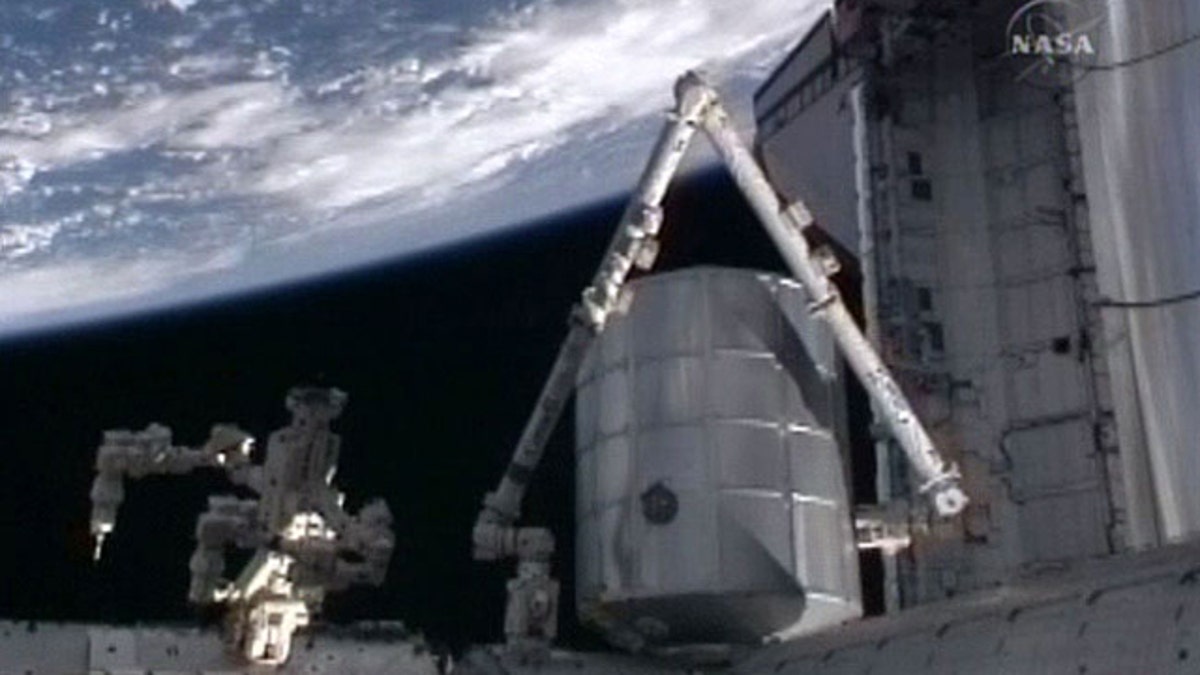
The cargo pod Leonardo, a multi-purpose logistics module for the International Space Station, is attached to the Earth-facing berth of the outpost's Harmony node on April 8, 2010 after being moved from shuttle Discovery's payload bay during the STS-131 mission. (NASA TV)
HOUSTON – Astronauts moved a cargo module the size of a mini bus the short distance from space shuttle Discovery's payload bay to the International Space Station's (ISS) Harmony node Thursday morning, setting the stage for a carefully choreographed ballet to begin transferring tons of supplies and equipment to and from and the orbiting laboratory.
The space station special delivery was performed by STS-131 mission specialists Stephanie Wilson and Naoko Yamazaki, Japan's second female astronaut, who as the shuttle crew's loadmaster -- or cargo chief -- will oversee the nearly 120 hours of transfer work.
That work is spread across the next nine days to move new science equipment, fresh supplies and spare parts from the cargo pod to the space station, and then fill it again with broken equipment, trash and other gear for their return to Earth.
Using the station's Canadian robotic arm, Wilson and Yamazaki maneuvered the Italian-built module, named "Leonardo," to its berthing port on the nadir, or Earth-facing, side of Harmony and latched it into place at 12:24 a.m. EDT (0424 GMT) on Thursday as the shuttle and station were traveling 220 miles above the South Pacific ocean, north of New Zealand.
"Glad to have an MPLM aboard, let transfer begin!" radioed Wilson, after being congratulated by mission control for a job well done.
Discovery mission specialist Clayton Anderson, himself a former station resident, and station flight engineer Soichi Noguchi representing Japan worked through the procedures for several hours to enter Leonardo but ran into a brief snag opening its hatch. After waiting a few minutes for the pressure to equalize between the station's and the module's atmospheres, the astronauts were able to open Leonardo at 7:58 a.m. EDT (1158 GMT).
"Good news, we got the hatch open," radioed Anderson.
Moving the moving van
The Leonardo module is about 21 feet long and 15 feet wide, and weighed about 27,274 pounds -- 17,000 pounds of which were spare parts and equipment for the station's crew -- when it was packed for Discovery's 13-day mission. The shuttle docked at the station early Wednesday.
Some of the big ticket items for the station inside the moving van-like module are several racks of new science experiments, each of them the size of a double-wide refrigerator. The module also contains a new astronaut bedroom for the station, which will eventually be converted into the equivalent of space shower for crew hygiene.
Leonardo also delivers a novel device designed to create water for the station's crew using waste hydrogen and carbon dioxide gases. The process creates methane as well, which will be vented overboard, NASA engineers have said.
This is NASA's last round trip flight for Leonardo as a multi-purpose logistics module, or MPLM. When it next flies to the space station later this year, it will be attached permanently to serve as a walk-in closet and storage facility for the outpost's crew.
With the cargo module now attached to the ISS, Discovery's payload bay is left empty less a huge spare ammonia coolant tank to be installed on the station's exterior during the mission's three planned spacewalks. The first spacewalk is slated to begin on Friday.
Shuttle heat shield analysis
Before Leonardo could be moved into place, engineers on Earth needed to first clear the heat shield on Discovery's starboard, or right, wing from needing further precautionary damage inspections because once installed, it would have been difficult to maneuver the shuttle's robotic arm to where it could gather the data needed.
A main antenna failure on Discovery forced the shuttle crew to wait until arriving at the station to beam the preliminary data collected on Tuesday to Earth.
Mission managers will continue to sift through the data to determine if Discovery's heat shield has suffered any damage severe enough to warrant extra inspections or repairs. So far, NASA has found no cause for concern with the shuttle's heat shield.
The inspections are a standard part of every NASA shuttle mission since the tragic loss of shuttle Columbia and seven astronauts in 2003. Heat shield damage caused by debris during liftoff caused the disaster, so NASA has developed inspection and repair techniques to keep close watch on shuttle health.
The current shuttle mission is one of NASA's four final shuttle missions before the agency retires its orbiter fleet in the fall.
Space station flight director Ed Van Cise said that high data traffic on the space station's own communications network slowed the transfer of Discovery's heat shield inspection data to Earth.
"As we're all used to at home, sometimes some networks are slower than others," Van Cise said.
